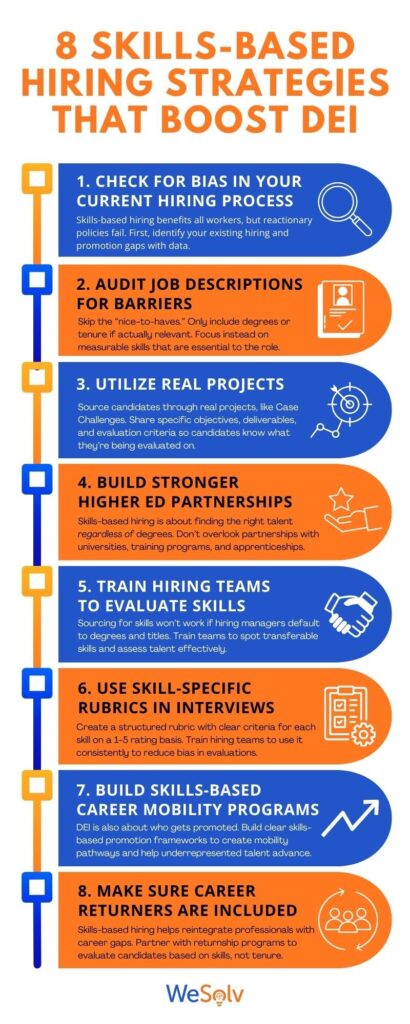2025 is already proving that skills-based hiring isn’t just a trend—it’s a necessity.
Many companies today are rethinking how they assess talent. Job skill requirements are expected to shift 68% by 2030 due to AI and other tech advancements, and hiring managers are already struggling to fill roles. Meanwhile, workers — perhaps especially those from underrepresented groups — are racing to reskill and upskill. One major healthcare company reports 45% of its upskilling program enrollees are BIPOC, and 80% of Black and 71% of Latino workers without access to this training want it (vs. 62% of White workers).
Creating more inroads for these candidates continues to make business sense. Companies with diverse workforces earn 2.5x higher cash flow per employee and make better decisions 87% of the time. But with recent lawsuits challenging DEI hiring initiatives, we’re reminded that progress isn’t guaranteed—it’s intentional.
Against this backdrop, skills-based hiring offers a path to more equity and more business success. It enables hiring systems that evaluate and reward candidates of all backgrounds and identities for their actual abilities, creating the conditions for actual meritocracy. Consider:
- Four-year degree requirements automatically eliminate 76% of Black and 83% of Latino workers.
- Hiring for skills instead of degrees is 5x more predictive of job performance.
- 90% of employers with skills-based hiring practices saw improved workforce diversity AND a reduction in mis-hires in 2024.
- Hiring systems that 1) recognize transferable skills and 2) identify skill overlaps between lower-paid and more senior roles can open doors to leadership and economic opportunity for skilled but underrepresented workers.
The gap between talent and opportunity has never been more urgent, and it’s clear that hiring for skills is the way forward. But many hiring processes haven’t caught up. And without hiring methods that can accurately assess skills, companies risk falling back on outdated, biased tactics that fail to evaluate candidate fit.
So, how can your organization adopt skills-based hiring in a way that goes beyond buzzwords and builds frameworks for real career mobility for all, including underrepresented talent? Below, we’ve outlined effective skills-based hiring strategies that instill equity, ensure candidate fit, and build more adaptable workforces.
8 Skills-Based Hiring Strategies That Benefit DEI

1. Assessing Biases in Your Current Hiring Process
We know skills-based hiring benefits all workers, including those from underrepresented backgrounds. But as we’ve also seen from today’s attacks on DEI, policies implemented out of reaction – not intention – are the first to fall.
Before rapidly shifting to a skills-based approach, make sure you’ve got a firm grip on where hiring and promotion gaps at your organization currently exist. This can be done with the help of employee surveys, analyses of historic diversity data, and by using tools like WeSolv’s free Hiring Bias Assessment.
2. Auditing Job Requirements to Remove Unnecessary Barriers
Many job descriptions include degree requirements and experience thresholds that disproportionately exclude underrepresented talent. Conduct a skills audit to identify what’s truly essential for success in each role, taking care to avoid laundry lists of “nice-to-have” skills. Partner with hiring managers to rewrite job descriptions with a focus on measurable skills and competencies, not credentials or tenure.
Putting your job descriptions through tools like Textio can screen for biased language that could be discouraging women, people of color, or other underrepresented candidates from applying.
3. Making Project-Based Recruiting Transparent
Real project recruiting gives candidates the chance to show their skills in action. But it’s only beneficial to DEI (and to your employer brand) if candidates know exactly what they’re being evaluated on. Without process and scoring transparency, real project recruiting can feel like just another unclear, time-intensive interview that leaves candidates in the dark.
Outline specific objectives, deliverables, and evaluation criteria so candidates know what’s expected. This transparency makes it easier for both candidates and hiring teams to assess performance and alignment accurately. (FYI, clear and transparent candidate criteria is a benefit of WeSolv’s Case Challenges.)
4. Expanding Sourcing Beyond Traditional Pipelines
Skills-based hiring isn’t about removing degrees — it’s about broadening access and evaluating for skills, no matter the degrees a candidate does or doesn’t have. Strengthen sourcing by partnering with universities, community colleges, skills-training programs, and apprenticeships where underrepresented talent is seeking opportunities. On the university side, career services departments can do their part to build up these relationships by creating employer advisory boards and hosting industry-specific networking events.
5. Training Hiring Teams to Evaluate Skills, Not Resumes
A common skills-based hiring mistake is sourcing candidates based on skills but evaluating them using traditional markers like degrees or job titles. Without sufficient guidance and training, it’s only natural that hiring managers will default to what they know. And for a lot of people, what they know is recruiting and hiring talent by focusing on degrees, job titles, or previous companies, rather than evaluating candidates’ skills directly.
Train recruiters and hiring teams not only to craft skills-focused job descriptions but on how to spot transferable skills in candidates. You can conduct training sessions where recruiters and hiring managers review anonymized résumés from nontraditional candidates with an eye toward overlooked strengths, practice conducting structured interviews, and learn how to use measurable skills assessments in hiring. For example, WeSolv grades candidates’ Case Challenges based on a weighted scorecard. Speaking of…
6. Using Skill-Specific Hiring Rubrics to Ensure Fairness and Objectivity
Even when hiring is skills-based, subjective judgments can creep in. Design a structured rubric that breaks down each required skill into clear, observable criteria. For example, if assessing project management skills, rate candidates on their ability to break down tasks, manage competing deadlines, and communicate progress—rather than relying on past job titles as a proxy. Train hiring teams to use these rubrics consistently, scoring candidates separately before group discussions to reduce bias.
7. Building Skills-Based Internal Mobility Programs
DEI success isn’t just about who gets hired—it’s about who gets promoted, too. Many companies prioritize external hiring for advanced roles, unintentionally sidelining internal employees from underrepresented backgrounds.
To correct this, build clear, skills-based promotion frameworks so employees understand exactly what competencies they need in order to advance. For instance, a customer support rep eyeing a product manager role could enter a structured internal mobility program where employees can earn skill badges or certifications that qualify them for promotions, raises, or new roles. By completing a series of skill-based projects, they can be considered for advancement — without needing a specific degree or tenure requirement. This ensures underrepresented talent isn’t just hired but also has a pathway to leadership.
8. Using Skills-Based Hiring to Tap into the Untapped Talent of Career Returners
Many talented professionals—especially women and caregivers—take career breaks and struggle to re-enter the workforce due to résumé gaps. A skills-based approach can reintegrate them effectively. Partner with programs like Path Forward or iRelaunch to create structured returnships where candidates demonstrate skills through paid project-based work. Eliminate tenure-based requirements and instead evaluate returners on up-to-date, relevant skills to ensure fair hiring.
By expanding skills-based hiring with these strategies, companies can unlock talent that’s often overlooked while making real progress on DEI.
Unlock the advantages of real-world projects designed to improve hiring and DEI outcomes. Learn about the WeSolv Case Challenge system.

